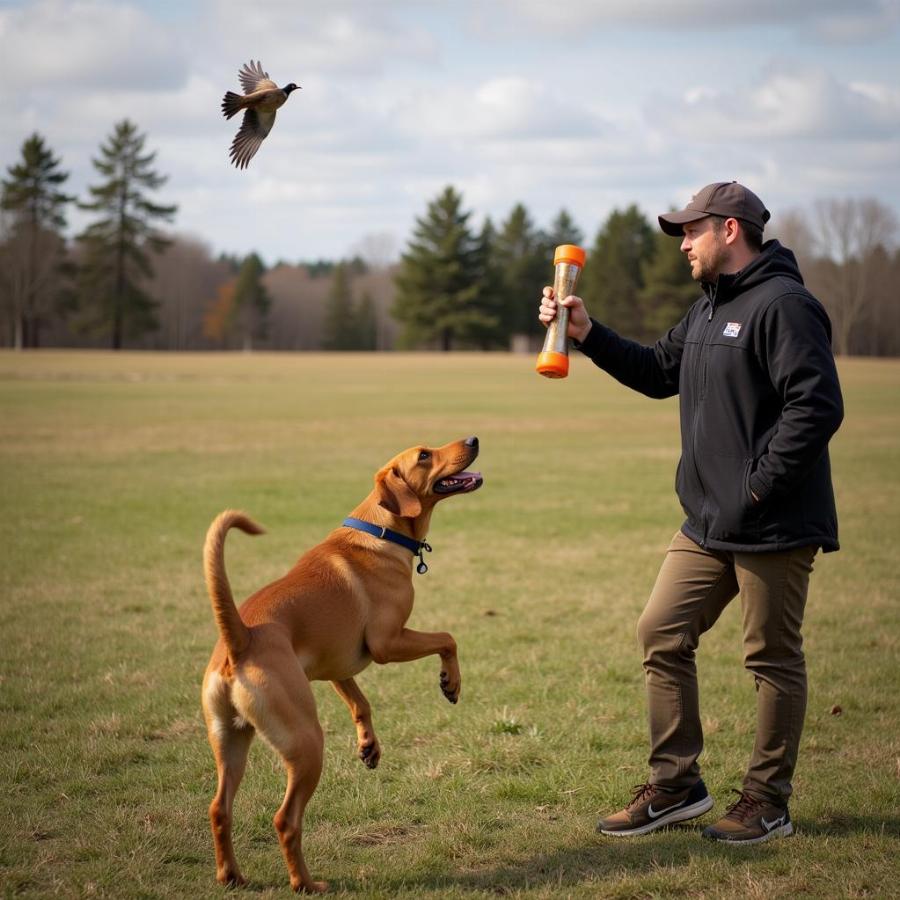Gun dog training is a rewarding journey that transforms your energetic canine companion into a skilled hunting partner. It’s about building a strong bond, fostering trust, and honing natural instincts through consistent practice and positive reinforcement. This guide delves into the essential aspects of gun dog training, equipping you with the knowledge and techniques to nurture your dog’s potential and enjoy successful hunts together.
Understanding the Basics of Gun Dog Training
Before embarking on gun dog training, it’s crucial to understand the fundamentals. This involves recognizing your dog’s breed-specific traits, setting realistic expectations, and creating a positive learning environment. Gun dog breeds, such as pointers, retrievers, and spaniels, possess innate hunting instincts, but these instincts need to be channeled through proper training.
Choosing the Right Training Approach
Several training methods exist, each with its pros and cons. Positive reinforcement, using rewards and praise, is generally the most effective approach. It builds a positive association with training and encourages your dog to actively participate. Avoid harsh corrections or punishment, which can damage your dog’s confidence and hinder the learning process.
Essential Gun Dog Training Stages
Gun dog training typically progresses through several stages, starting with basic obedience and gradually introducing more specialized skills.
Basic Obedience: The Foundation
A well-trained gun dog must master basic commands like sit, stay, come, and heel. These commands provide a foundation for all subsequent training and ensure your dog’s safety in the field.
Introduction to Birds and Gunfire
Introducing your dog to birds, initially through dummies or scented training aids, is a crucial step. Gradually introduce gunfire, starting with a starter pistol at a distance, to desensitize your dog to the sound.
Retrieving and Pointing
Retrieving is a fundamental skill for many gun dogs. Start with short retrieves and gradually increase the distance and complexity of the terrain. For pointing breeds, encourage and refine their natural pointing instinct through consistent exposure to game birds.
Field Training and Advanced Skills
Field training simulates real hunting scenarios, allowing your dog to practice its skills in a more realistic environment. This stage involves working with live birds and honing advanced skills like quartering, flushing, and retrieving in various cover types.
Gun Dog Training Gear and Equipment
Investing in the right gear and equipment can enhance your training efforts. Essential items include a training collar, a long lead, dummies, training scents, and potentially an e-collar for advanced training. Remember earmuffs for dogs can protect their hearing during gunfire introduction.
Common Gun Dog Training Challenges and Solutions
Gun dog training isn’t always smooth sailing. You might encounter challenges like distractions, lack of focus, or resistance to certain commands. Patience, consistency, and a positive approach are key to overcoming these hurdles. Remember that every dog learns at its own pace, and seeking guidance from experienced trainers can be invaluable.
 Gun Dog Training Challenges
Gun Dog Training Challenges
Maintaining Your Gun Dog’s Skills
Gun dog training is an ongoing process. Even after your dog has mastered the basics, regular practice and reinforcement are essential to maintain its skills and ensure its continued success in the field.
Conclusion
Gun dog training requires dedication, patience, and a deep understanding of your dog’s abilities. By following a structured approach, utilizing positive reinforcement, and addressing challenges effectively, you can transform your canine companion into a skilled and reliable hunting partner. Remember to maintain consistent training to ensure your dog remains a valuable asset in the field for years to come. With proper gun dog training, you’ll not only have a proficient hunting companion but also strengthen the bond you share. Looking for the best pointer dogs? Check out our guide.
FAQ
- When should I start gun dog training? Ideally, begin basic obedience training as early as possible, even with puppies.
- How long does gun dog training take? The duration varies depending on the dog’s breed, age, and individual learning pace.
- What are the most important qualities of a good gun dog? Obedience, a strong prey drive, and a willingness to please are essential qualities.
- Can I train my gun dog myself? Yes, but seeking guidance from experienced trainers, especially for advanced skills, can be beneficial.
- What are some common mistakes to avoid in gun dog training? Using harsh corrections, inconsistent training, and rushing the process are common pitfalls.
- What kind of training collar is best for a gun dog? A flat collar or a slip lead is suitable for basic training. An e-collar may be used for advanced training under expert guidance.
- How can I find a reputable gun dog trainer? Seek recommendations from veterinarians, hunting clubs, or other dog owners.
Further Reading and Related Questions
Interested in learning more about specific hunting dog breeds? Check out our article on german pointer dog hunting. Have you seen the hilarious dog with gun meme? It’s a lighthearted take on the serious business of gun dog training. Maintaining your dog’s health is crucial. Learn how to clean dog eyes crust for optimal eye health.
Beaut Dogs: Your Premier Resource for Canine Expertise
Beaut Dogs is your one-stop shop for all things related to dog care, offering expert advice, breed information, and training tips. From understanding specific breed traits to mastering essential commands, Beaut Dogs provides a wealth of knowledge for dog lovers of all levels. When you need assistance, contact us via Email: [email protected] to get detailed and accurate answers from Beaut Dogs. Visit us at https://beautdogs.com.